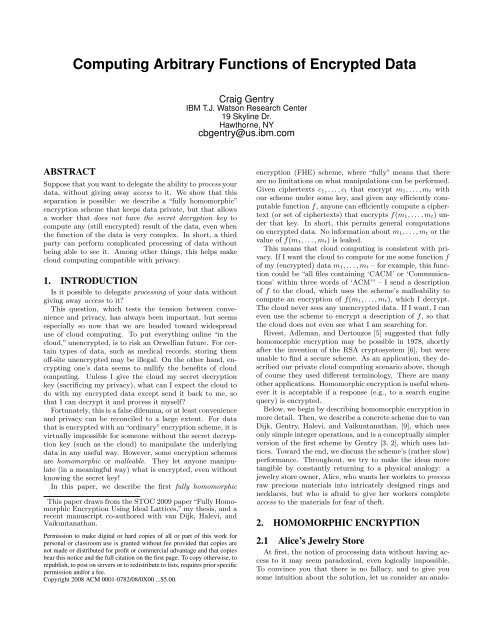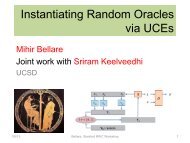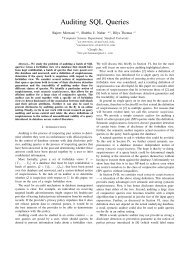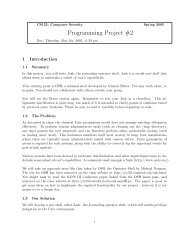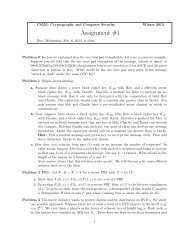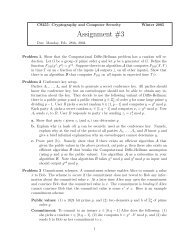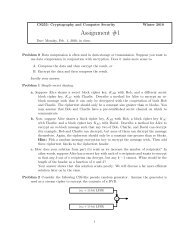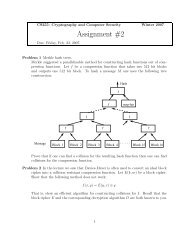Computing Arbitrary Functions of Encrypted Data - Stanford Crypto ...
Computing Arbitrary Functions of Encrypted Data - Stanford Crypto ...
Computing Arbitrary Functions of Encrypted Data - Stanford Crypto ...
You also want an ePaper? Increase the reach of your titles
YUMPU automatically turns print PDFs into web optimized ePapers that Google loves.
ABSTRACT<br />
<strong>Computing</strong> <strong>Arbitrary</strong> <strong>Functions</strong> <strong>of</strong> <strong>Encrypted</strong> <strong>Data</strong><br />
Suppose that you want to delegate the ability to process your<br />
data, without giving away access to it. We show that this<br />
separation is possible: we describe a “fully homomorphic”<br />
encryption scheme that keeps data private, but that allows<br />
a worker that does not have the secret decryption key to<br />
compute any (still encrypted) result <strong>of</strong> the data, even when<br />
the function <strong>of</strong> the data is very complex. In short, a third<br />
party can perform complicated processing <strong>of</strong> data without<br />
being able to see it. Among other things, this helps make<br />
cloud computing compatible with privacy.<br />
1. INTRODUCTION<br />
Is it possible to delegate processing <strong>of</strong> your data without<br />
giving away access to it?<br />
This question, which tests the tension between convenience<br />
and privacy, has always been important, but seems<br />
especially so now that we are headed toward widespread<br />
use <strong>of</strong> cloud computing. To put everything online “in the<br />
cloud,” unencrypted, is to risk an Orwellian future. For certain<br />
types <strong>of</strong> data, such as medical records, storing them<br />
<strong>of</strong>f-site unencrypted may be illegal. On the other hand, encrypting<br />
one’s data seems to nullify the benefits <strong>of</strong> cloud<br />
computing. Unless I give the cloud my secret decryption<br />
key (sacrificing my privacy), what can I expect the cloud to<br />
do with my encrypted data except send it back to me, so<br />
that I can decrypt it and process it myself?<br />
Fortunately, this is a false dilemma, or at least convenience<br />
and privacy can be reconciled to a large extent. For data<br />
that is encrypted with an “ordinary” encryption scheme, it is<br />
virtually impossible for someone without the secret decryption<br />
key (such as the cloud) to manipulate the underlying<br />
data in any useful way. However, some encryption schemes<br />
are homomorphic or malleable. They let anyone manipulate<br />
(in a meaningful way) what is encrypted, even without<br />
knowing the secret key!<br />
In this paper, we describe the first fully homomorphic<br />
This paper draws from the STOC 2009 paper “Fully Homomorphic<br />
Encryption Using Ideal Lattices,” my thesis, and a<br />
recent manuscript co-authored with van Dijk, Halevi, and<br />
Vaikuntanathan.<br />
Permission to make digital or hard copies <strong>of</strong> all or part <strong>of</strong> this work for<br />
personal or classroom use is granted without fee provided that copies are<br />
not made or distributed for pr<strong>of</strong>it or commercial advantage and that copies<br />
bear this notice and the full citation on the first page. To copy otherwise, to<br />
republish, to post on servers or to redistribute to lists, requires prior specific<br />
permission and/or a fee.<br />
Copyright 2008 ACM 0001-0782/08/0X00 ...$5.00.<br />
Craig Gentry<br />
IBM T.J. Watson Research Center<br />
19 Skyline Dr.<br />
Hawthorne, NY<br />
cbgentry@us.ibm.com<br />
encryption (FHE) scheme, where “fully” means that there<br />
are no limitations on what manipulations can be performed.<br />
Given ciphertexts c1, . . . , ct that encrypt m1, . . . , mt with<br />
our scheme under some key, and given any efficiently computable<br />
function f, anyone can efficiently compute a ciphertext<br />
(or set <strong>of</strong> ciphertexts) that encrypts f(m1, . . . , mt) under<br />
that key. In short, this permits general computations<br />
on encrypted data. No information about m1, . . . , mt or the<br />
value <strong>of</strong> f(m1, . . . , mt) is leaked.<br />
This means that cloud computing is consistent with privacy.<br />
If I want the cloud to compute for me some function f<br />
<strong>of</strong> my (encrypted) data m1, . . . , mt – for example, this function<br />
could be “all files containing ‘CACM’ or ‘Communications’<br />
within three words <strong>of</strong> ‘ACM’” – I send a description<br />
<strong>of</strong> f to the cloud, which uses the scheme’s malleability to<br />
compute an encryption <strong>of</strong> f(m1, . . . , mt), which I decrypt.<br />
The cloud never sees any unencrypted data. If I want, I can<br />
even use the scheme to encrypt a description <strong>of</strong> f, so that<br />
the cloud does not even see what I am searching for.<br />
Rivest, Adleman, and Dertouzos [5] suggested that fully<br />
homomorphic encryption may be possible in 1978, shortly<br />
after the invention <strong>of</strong> the RSA cryptosystem [6], but were<br />
unable to find a secure scheme. As an application, they described<br />
our private cloud computing scenario above, though<br />
<strong>of</strong> course they used different terminology. There are many<br />
other applications. Homomorphic encryption is useful whenever<br />
it is acceptable if a response (e.g., to a search engine<br />
query) is encrypted.<br />
Below, we begin by describing homomorphic encryption in<br />
more detail. Then, we describe a concrete scheme due to van<br />
Dijk, Gentry, Halevi, and Vaikuntanathan, [9], which uses<br />
only simple integer operations, and is a conceptually simpler<br />
version <strong>of</strong> the first scheme by Gentry [3, 2], which uses lattices.<br />
Toward the end, we discuss the scheme’s (rather slow)<br />
performance. Throughout, we try to make the ideas more<br />
tangible by constantly returning to a physical analogy: a<br />
jewelry store owner, Alice, who wants her workers to process<br />
raw precious materials into intricately designed rings and<br />
necklaces, but who is afraid to give her workers complete<br />
access to the materials for fear <strong>of</strong> theft.<br />
2. HOMOMORPHIC ENCRYPTION<br />
2.1 Alice’s Jewelry Store<br />
At first, the notion <strong>of</strong> processing data without having access<br />
to it may seem paradoxical, even logically impossible.<br />
To convince you that there is no fallacy, and to give you<br />
some intuition about the solution, let us consider an analo-
gous problem in (a fictional version <strong>of</strong>) the “physical world.”<br />
Alice owns a jewelry store. She has raw precious materials<br />
– gold, diamonds, silver, etc. – that she wants her workers<br />
to assemble into intricately designed rings and necklaces.<br />
But she distrusts her workers and assumes that they will<br />
steal her jewels if given the opportunity. In other words,<br />
she wants her workers to process the materials into finished<br />
pieces, without giving them access to the materials. What<br />
does she do?<br />
Here is her plan. She uses a transparent impenetrable<br />
glovebox, secured by a lock for which only she has the key.<br />
She puts the raw precious materials inside the box, locks<br />
it, and gives it to a worker. Using the gloves, the worker<br />
assembles the ring or necklace inside the box. Since the<br />
box is impenetrable, the worker cannot get to the precious<br />
materials, and figures he might as well return the box to<br />
Alice, with the finished piece inside. Alice unlocks the box<br />
with her key and extracts the ring or necklace. In short,<br />
the worker processes the raw materials into a finished piece,<br />
without having true access to the materials.<br />
The locked impenetrable box, with raw precious materials<br />
inside, represents an encryption <strong>of</strong> the initial data m1, . . . , mt,<br />
which can be accessed only with the secret decryption key.<br />
The gloves represent the homomorphism or malleability <strong>of</strong><br />
the encryption scheme, which allows the raw data to be<br />
manipulated while it is inside the “encryption box.” The<br />
completed ring or necklace inside the box represents the encryption<br />
<strong>of</strong> f(m1, . . . , mt), the desired function <strong>of</strong> the initial<br />
data. Note that “lack <strong>of</strong> access” is represented by lack <strong>of</strong><br />
physical access, as opposed to lack <strong>of</strong> visual access, to the<br />
jewels. (For an analogy that uses lack <strong>of</strong> visual access, consider<br />
a photograph developer’s darkroom.)<br />
Of course, Alice’s jewelry store is only an analogy. It<br />
does not represent some aspects <strong>of</strong> homomorphic encryption<br />
well, and taking it too literally may be more confusing than<br />
helpful. We discuss some flaws in the analogy at the end<br />
<strong>of</strong> this section, after we describe homomorphic encryption<br />
more formally. Despite its flaws, we return to the analogy<br />
throughout, since it motivates good questions, and represents<br />
some aspects <strong>of</strong> our solution quite well – most notably,<br />
“bootstrapping,” which we discuss in Section 4.<br />
2.2 Homomorphic Encryption: Functionality<br />
An encryption scheme E has three algorithms: KeyGen E,<br />
Encrypt E and Decrypt E , all <strong>of</strong> which must be efficient – that<br />
is, run in time poly(λ), polynomial in a security parameter λ<br />
that specifies the bit-length <strong>of</strong> the keys. In a symmetric, or<br />
secret-key, encryption scheme, KeyGen E uses λ to generate<br />
a single key that is used in both Encrypt E and Decrypt E ,<br />
first to map a message to a ciphertext, and then to map<br />
the ciphertext back to the message. In an asymmetric, or<br />
public-key, encryption scheme, KeyGen E uses λ to generate<br />
two keys – a public encryption key pk, which may be made<br />
available to everyone, and a secret decryption key sk. As<br />
a physical analogy for an asymmetric encryption scheme,<br />
one can think <strong>of</strong> Alice’s public key as a padlock, which she<br />
constructs and distributes, that can be locked without a key.<br />
Anyone can put a message inside a box secured by Alice’s<br />
padlock (encrypt), and mail it via a public channel to Alice,<br />
but only Alice has the key needed to unlock it (decrypt).<br />
A homomorphic encryption scheme can be either symmetric<br />
or asymmetric, but we will focus on the asymmetric case.<br />
It has a fourth algorithm EvaluateE, which is associated to a<br />
set FE <strong>of</strong> permitted functions. For any function f in FE and<br />
any ciphertexts c1, . . . , ct with ci ← Encrypt E(pk, mi), the<br />
algorithm EvaluateE(pk, f, c1, . . . , ct) outputs a ciphertext c<br />
that encrypts f(m1, . . . , mt) – i.e., such that Decrypt E (sk, c) =<br />
f(m1, . . . , mt). (For convenience, we will assume that f has<br />
one output. If f has k outputs, then EvaluateE outputs<br />
k ciphertexts that encrypt f(m1, . . . , mt) collectively.) As<br />
shorthand, we say that E can handle functions in FE. For a<br />
function f not in FE, there is no guarantee that EvaluateE<br />
will output anything meaningful. Typically EvaluateE is undefined<br />
for such a function.<br />
As described thus far, it is trivial to construct an encryption<br />
scheme that can handle all functions. Just define<br />
EvaluateE as follows: simply output c ← (f, c1, . . . , ct),<br />
without “processing” the ciphertexts at all. Modify Decrypt E<br />
slightly: to decrypt c, decrypt c1, . . . , ct to obtain m1, . . . , mt,<br />
and then apply f to these messages.<br />
But this trivial solution obviously does not conform to the<br />
spirit <strong>of</strong> what we are trying to achieve – to delegate the data<br />
processing (while maintaining privacy). The trivial solution<br />
is as if, in Alice’s jewelry store, the worker simply sends<br />
the box (which need not have gloves) back to Alice without<br />
doing any work on the raw precious materials, and Alice<br />
unlocks the box, extracts the materials, and assembles the<br />
ring or necklace herself.<br />
So, how do we formalize what it means to delegate? Intuitively,<br />
the purpose <strong>of</strong> delegation is to reduce one’s workload.<br />
We can formalize this in terms <strong>of</strong> the running times<br />
(i.e., complexity) <strong>of</strong> the algorithms. Specifically, we require<br />
that decrypting c (the ciphertext output by EvaluateE) takes<br />
the same amount <strong>of</strong> computation as decrypting c1 (a ciphertext<br />
output by Encrypt E ). Moreover, we require that c is the<br />
same size as c1. We refer to these as the compact ciphertexts<br />
requirement. Again, the size <strong>of</strong> c and the time needed to decrypt<br />
it do not grow with the complexity <strong>of</strong> f; rather, they<br />
are completely independent <strong>of</strong> f (unless f has multiple outputs).<br />
Also, <strong>of</strong> course, the complexity <strong>of</strong> Decrypt E , as well<br />
as the complexity <strong>of</strong> KeyGen E and Encrypt E, must remain<br />
polynomial in λ.<br />
E is fully homomorphic if it can handle all functions, has<br />
compact ciphertexts, and EvaluateE is efficient in a way that<br />
we specify below. The trivial solution above certainly is not<br />
fully homomorphic, since the size <strong>of</strong> the ciphertext output by<br />
EvaluateE, as well as the time needed to decrypt it, depend<br />
on the function being evaluated. In terms <strong>of</strong> Alice’s jewelry<br />
store, our definition <strong>of</strong> fully homomorphic captures the bestcase<br />
scenario for Alice: her workers can assemble arbitrarily<br />
complicated pieces inside the box, but the work needed to<br />
assemble has no bearing on the work Alice needs to do to<br />
unlock the box and extract the piece.<br />
We want our fully homomorphic scheme to be efficient for<br />
the worker, as well. In particular, we want the complexity<br />
<strong>of</strong> EvaluateE – like the other algorithms <strong>of</strong> E – to depend<br />
only polynomially on the security parameter. But clearly<br />
its complexity must also depend on the function being evaluated.<br />
How do we measure the complexity <strong>of</strong> f? Perhaps<br />
the most obvious measure is the running time Tf <strong>of</strong> a Turing<br />
machine that computes f. We use a related measure,<br />
the size Sf <strong>of</strong> a boolean circuit (i.e., the number <strong>of</strong> AND,<br />
OR, and NOT gates) that computes f. Any function that<br />
can be computed in Tf steps on a Turing machine can be<br />
expressed as a circuit with about Tf gates. More precisely,<br />
Sf < k · Tf · log Tf for some small constant k. Overall, we
say that EvaluateE is efficient if there is a polynomial g such<br />
that, for any function f that is represented by a circuit <strong>of</strong><br />
size Sf , EvaluateE(pk, f, c1, . . . , ct) has complexity at most<br />
Sf · g(λ).<br />
The circuit representation <strong>of</strong> f is also useful because it<br />
breaks the computation <strong>of</strong> f down into simple steps – e.g.,<br />
AND, OR, and NOT gates. Moreover, to evaluate these<br />
gates, it is enough to be able to add, subtract and multiply.<br />
(In fact, it is enough if we can add, subtract and<br />
multiply modulo 2.) In particular, for x, y ∈ {0, 1}, we<br />
have AND(x, y) = xy, OR(x, y) = 1 − (1 − x)(1 − y) and<br />
NOT(x) = 1 − x. So, to obtain a fully homomorphic encryption<br />
scheme, all we need is a scheme that operates on<br />
ciphertexts so as to add, subtract, and multiply the underlying<br />
messages, indefinitely.<br />
But is the circuit representation <strong>of</strong> f – or some arithmetized<br />
version <strong>of</strong> it in terms <strong>of</strong> addition, subtraction and<br />
multiplication – necessarily the most efficient way to evaluate<br />
f? In fact, some functions, like binary search, take much<br />
longer on a Turing machine or circuit than on a random access<br />
machine. On a random access machine, a binary search<br />
algorithm on t ordered items only needs to “touch” O(log t)<br />
<strong>of</strong> its inputs.<br />
A moment’s thought shows that random-access speedups<br />
cannot work if the data is encrypted. Unless we know<br />
something a priori about the relationship between f and<br />
m1, . . . , mt, the algorithm EvaluateE(pk, f, c1, . . . , ct) must<br />
touch all <strong>of</strong> the input ciphertexts, and therefore have complexity<br />
at least linear in the number <strong>of</strong> inputs. To put it another<br />
way, if EvaluateE (for some reason) did not touch the<br />
second half <strong>of</strong> the ciphertexts, this would leak information<br />
about the second half <strong>of</strong> the underlying messages – namely,<br />
their irrelevance in the computation <strong>of</strong> f – and this leakage<br />
would contradict the security <strong>of</strong> the encryption scheme.<br />
While EvaluateE must have running time at least linear in<br />
t as an unavoidable cost <strong>of</strong> the complete privacy that homomorphic<br />
encryption provides, a trade<strong>of</strong>f is possible. If I<br />
am willing to reveal – e.g., in the cloud computing context<br />
– that the files that I want are contained in a certain 1%<br />
<strong>of</strong> my data, then I may help the cloud reduce its work by a<br />
factor <strong>of</strong> 100.<br />
Another artifact <strong>of</strong> using a fixed circuit representation <strong>of</strong><br />
f is that the size <strong>of</strong> the output – i.e., the number <strong>of</strong> output<br />
wires in the circuit – must be fixed in advance. For example,<br />
when I request all <strong>of</strong> my files that contain a combination<br />
<strong>of</strong> keywords, I should also specify how much data I want<br />
retrieved – e.g., one megabyte. From my request, the cloud<br />
will generate a circuit for a function that outputs the first<br />
megabyte <strong>of</strong> the correct files, where that output is truncated<br />
(if too much <strong>of</strong> my data satisfies my request), or padded with<br />
zeros (if too little). A moment’s thought shows that this<br />
is also unavoidable. There is no way the cloud can avoid<br />
truncating or padding unless it knows something a priori<br />
about the relationship between the function and my data.<br />
2.3 Homomorphic Encryption: Security<br />
In terms <strong>of</strong> security, the weakest requirement for an encryption<br />
scheme is one-wayness: given the public key pk and<br />
a ciphertext c that encrypts unknown message m under pk,<br />
it should be “hard” to output m. “Hard” means that any<br />
algorithm or “adversary” A that runs in poly(λ) time has a<br />
negligible probability <strong>of</strong> success over the choices <strong>of</strong> pk and<br />
m (i.e., the probability it outputs m is less than 1/λ k for<br />
any constant k).<br />
Nowadays, we typically require an encryption scheme to<br />
have a stronger security property, called semantic security<br />
against chosen-plaintext attacks (CPA) [4]: given a ciphertext<br />
c that encrypts either m0 or m1, it is hard for an adversary<br />
to decide which, even if it is allowed to choose m0<br />
and m1. Here, “hard” means that if the adversary A runs<br />
in polynomial time and guesses correctly with probability<br />
1/2 + ɛ, then ɛ, called A’s advantage, must be negligible.<br />
If this advantage is non-negligible, then we say (informally)<br />
that the adversary breaks the semantic security <strong>of</strong> the encryption<br />
scheme.<br />
If an encryption scheme is deterministic – i.e., if there is<br />
only one ciphertext that encrypts a given message – then it<br />
cannot be semantically secure. An attacker can easily tell<br />
whether c encrypts m0, by running c0 ← Encrypt(pk, m0)<br />
and seeing if c and c0 are the same. A semantically secure<br />
encryption scheme must be probabilistic – i.e., there<br />
must be many ciphertexts that encrypt a given message,<br />
and Encrypt E must choose one randomly according to some<br />
distribution.<br />
One can prove the (conditional) one-wayness or semantic<br />
security <strong>of</strong> an encryption scheme by reducing a hard problem<br />
to breaking the encryption scheme. For example, suppose<br />
one shows that if there is an efficient algorithm that breaks<br />
the encryption scheme, then this algorithm can be used as a<br />
subroutine in an efficient algorithm that factors large numbers.<br />
Then, under the assumption that factoring is hard –<br />
i.e., that no poly(λ)-time algorithm can factor λ-bit numbers<br />
– the reduction implies that the encryption scheme must be<br />
hard to break.<br />
Semantic security <strong>of</strong> a homomorphic encryption scheme<br />
is defined in the same way as for an ordinary encryption<br />
scheme, without reference to the EvaluateE algorithm. If<br />
we manage to prove a reduction – i.e., that an attacker that<br />
breaks E can be used to solve a hard problem like factoring –<br />
then this reduction holds whether or not E has an EvaluateE<br />
algorithm that works for a large set <strong>of</strong> functions.<br />
To understand the power <strong>of</strong> semantic security, let us reconsider<br />
our cloud computing application. Sometime after<br />
storing her encrypted files in the cloud, Alice wants the cloud<br />
to retrieve the files that have a certain combination <strong>of</strong> keywords.<br />
Suppose that in its response, the cloud sends ciphertexts<br />
that encrypt the first three files. Can’t the cloud just<br />
see that the first three encrypted files that it is storing for<br />
Alice happen to encrypt the same content as the three files<br />
that it sends to Alice? Not if the scheme is semantically<br />
secure. Even though some <strong>of</strong> the stored ciphertexts encrypt<br />
the same content as the sent ciphertexts, the cloud cannot<br />
see this, because semantic security guarantees that it is hard<br />
to tell whether two ciphertexts encrypt the same content.<br />
Intuitively, it seems like the EvaluateE algorithm should<br />
make E easier to break, simply because this additional algorithm<br />
gives the attacker more power. Or, to put it in terms<br />
<strong>of</strong> the physical analogy, one would think that the easiest way<br />
to get inside the glovebox is to cut through the gloves, and<br />
that, the more flexible the gloves are, the easier the glovebox<br />
is to compromise; this suggests that, the more malleable the<br />
encryption scheme is, the easier it is to break. There is some<br />
truth to this intuition. Researchers [1, 8] showed that if E<br />
is a deterministic fully homomorphic encryption scheme (or,<br />
more broadly, one for which it is easy to tell whether two<br />
ciphertexts encrypt the same thing), then E can be broken
in sub-exponential time, and in only polynomial time (i.e.,<br />
efficiently) on a quantum computer. So, malleability seems<br />
to weaken the security <strong>of</strong> deterministic schemes. But these<br />
results do not apply to semantically secure schemes, such as<br />
ours.<br />
2.4 Some Flaws in the Physical Analogy<br />
The physical analogy represents some aspects <strong>of</strong> homomorphic<br />
encryption poorly. For example, the physical analogy<br />
suggests that messages that are encrypted separately<br />
are in different “encryption boxes” and cannot interact. Of<br />
course, this interaction is precisely the purpose <strong>of</strong> homomorphic<br />
encryption. To fix the analogy, one may imagine that<br />
the gloveboxes have a one-way insertion slot like the mail<br />
bins used by the post <strong>of</strong>fice. Then, messages can be added<br />
to the same encryption box as they arrive. (Even this fix is<br />
not entirely satisfactory.)<br />
Another flaw is that the output f(m1, . . . , mt) may have<br />
significantly fewer bits than m1, . . . , mt, whereas in the analogy<br />
(absent significant nuclear activity inside the glovebox)<br />
the conservation <strong>of</strong> mass dictates that the box will have<br />
at least as much material inside when the worker is done<br />
as when he started. Finally, in Alice’s jewelry store, even<br />
though a worker cannot extract the materials from a locked<br />
glovebox, he can easily tell whether or not a box contains a<br />
certain set <strong>of</strong> materials – i.e., the gloveboxes do not provide<br />
“semantic security.”<br />
3. A SOMEWHAT HOMOMORPHIC<br />
ENCRYPTION SCHEME<br />
On our way to fully homomorphic encryption, we begin by<br />
constructing a somewhat homomorphic encryption scheme E<br />
that can handle a limited class FE <strong>of</strong> permitted functions.<br />
EvaluateE(pk, f, c1, . . . , ct) does not work for functions f that<br />
are too complicated. Later, we will show to use E to obtain<br />
fully homomorphic encryption.<br />
3.1 Meanwhile in Alice’s Jewelry Store<br />
After figuring out how to use locked gloveboxes to get her<br />
workers to process her precious materials into fancy rings<br />
and necklaces, Alice puts in an order with Acme Glovebox<br />
Company. Unfortunately, the gloveboxes she receives are<br />
defective. After a worker uses the gloves for one minute, the<br />
gloves stiffen and become unusable. But some <strong>of</strong> the fanciest<br />
pieces take up to an hour to assemble. Alice sues Acme, but<br />
meanwhile she wonders: Is there some way I can use these<br />
defective boxes to get the workers to securely assemble even<br />
the most complicated pieces?<br />
She notices that the boxes, while defective, do have a property<br />
that might be useful. As expected, they have a one-way<br />
insertion slot, like post <strong>of</strong>fice mail bins. But they are also<br />
flexible enough so that it is possible to put one box inside another<br />
through the slot. She wonders whether this property<br />
might play a role in the solution to her problem...<br />
3.2 Our Somewhat Homomorphic Scheme<br />
Our somewhat homomorphic encryption scheme E, described<br />
below, is remarkably simple [9]. We describe it first<br />
as a symmetric encryption scheme. As an example parameter<br />
setting, for security parameter λ, set N = λ, P = λ 2<br />
and Q = λ 5 .<br />
An Encryption Scheme:<br />
KeyGen E (λ): The key is a random P -bit odd integer p.<br />
Encrypt E(p, m): To encrypt a bit m ∈ {0, 1}, set m ′ to be a<br />
random N-bit number such that m ′ = m mod 2. Output<br />
the ciphertext c ← m ′ + pq, where q is a random<br />
Q-bit number.<br />
Decrypt E(p, c): Output (c mod p) mod 2, where (c mod p) is<br />
the integer c ′ in (−p/2, p/2) such that p divides c − c ′ .<br />
Ciphertexts from E are near-multiples <strong>of</strong> p. We call (c mod<br />
p) the noise associated to the ciphertext c. It is the distance<br />
to the nearest multiple <strong>of</strong> p. Decryption works because the<br />
noise is m ′ , which has the same parity as the message. We<br />
call a ciphertext output by Encrypt a fresh ciphertext, since<br />
it has small (N-bit) noise.<br />
How is the scheme homomorphic? By simply adding, subtracting,<br />
or multiplying the ciphertexts as integers, we can<br />
add, subtract or multiply (modulo 2) the underlying messages.<br />
However, complications arise, because these operations<br />
increase the noise associated to resulting ciphertexts.<br />
Eventually, the noise become so large that decryption no<br />
longer reliably returns the correct result.<br />
Homomorphic Operations:<br />
AddE(c1, c2), SubE(c1, c2), MultE(c1, c2): the output ciphertext<br />
c is c1 + c2, c1 − c2, or c1 · c2.<br />
EvaluateE(f, c1, . . . , ct): Express the boolean function f as<br />
a circuit C with XOR and AND gates. Let C † be<br />
the same circuit as C, but with XOR and AND gates<br />
replaced by addition and multiplication gates over the<br />
integers. Let f † be the multivariate polynomial that<br />
corresponds to C † . Output c ← f † (c1, . . . , ct).<br />
Let us check that ciphertexts output by EvaluateE decrypt<br />
correctly. As a warm-up, let us consider MultE. Let c =<br />
c1 · c2, where ci’s noise is m ′ i, which has the same parity as<br />
the message mi. We have that<br />
c = m ′ 1 · m ′ 2 + pq ′<br />
for some integer q ′ . As long as the noises are small enough<br />
so that |m ′ 1 · m ′ 2| < p/2, we have that<br />
(c mod p) = m ′ 1 · m ′ 2<br />
and therefore (c mod p) mod 2 = m1 · m2, as it should be.<br />
We will consider the evaluation <strong>of</strong> more complicated functions<br />
momentarily, in Section 3.3.<br />
So far we only described a symmetric homomorphic encryption<br />
scheme. Turning it into a public-key scheme is<br />
easy, but adds some complexity. As before, the secret key is<br />
p. The public key consists <strong>of</strong> a list <strong>of</strong> integers that are essentially<br />
“encryptions <strong>of</strong> zero.” The list has length polynomial<br />
in λ. To encrypt a bit m, the ciphertext c is (essentially) m<br />
plus a random subset sum <strong>of</strong> the ciphertexts in the public<br />
key. If these ciphertexts have very small noise, the resulting<br />
ciphertext will also have small noise, and decryption will<br />
work properly: (c mod p) mod 2 will equal m, as before.<br />
3.3 How Homomorphic Is It?<br />
What is the set <strong>of</strong> permitted functions that our homomorphic<br />
encryption scheme E can handle?<br />
To answer this question, we need to analyze how the noise<br />
grows as we add and multiply ciphertexts. Encrypt E outputs
a fresh ciphertext with a small noise, at most N bits. As<br />
we AddE, SubE, or MultE ciphertexts, the output ciphertext<br />
becomes more noisy. Multiplication tends to increase the<br />
noise faster than addition or subtraction. In particular, for<br />
ciphertexts c1 and c2 with k1- and k2-bit noises, the ciphertext<br />
c ← c1 · c2 has (roughly) (k1 + k2)-bit noise.<br />
What happens when we perform many AddE, SubE, and<br />
MultE operations, as prescribed by the circuit representing<br />
a function f? Similar to what we saw above with multiplication,<br />
we have<br />
f † (c1, . . . , ct) = f † (m ′ 1, . . . , m ′ t) + pq ′<br />
for some integer q ′ , where m ′ i is the noise associated to ci. If<br />
|f † (m ′ 1, . . . , m ′ t)| < p/2, then (f † (c1, . . . , ct) mod p) equals<br />
f † (m ′ 1, . . . , m ′ t). And if we reduce this result modulo 2, we<br />
obtain the correct result: f(m1, . . . , mt).<br />
In short, the functions that E can handle are those for<br />
which |f † (a1, . . . , at)| is always less than p/2 if all <strong>of</strong> the ai<br />
are at most N bits.<br />
E is already quite powerful. As an example, it can handle<br />
an elementary symmetric polynomial <strong>of</strong> degree d in t variables,<br />
as long as 2 Nd · t<br />
< p/2, which is true (roughly)<br />
d<br />
when d < P/(N · log t). For our suggested parameters, this<br />
degree can be quite large: λ/(log t) = Ω(λ/ log λ). That E<br />
can evaluate polynomials <strong>of</strong> such high degree makes it “homomorphic<br />
enough” for many applications. For example, it<br />
works well when f is a highly parallelizable function – e.g., a<br />
basic keyword search – in which case f has fairly low degree.<br />
3.4 Semantic Security and Approximate GCDs<br />
Euclid showed that, given two integers x1 and x2, it is<br />
easy to compute their greatest common divisor (gcd). But<br />
suppose that x1 = s1 + p · q1 and x2 = s2 + p · q2 are nearmultiples<br />
<strong>of</strong> p, with s1 and s2 much smaller than p. When p<br />
is only an approximate gcd, is it still possible to compute p<br />
efficiently – i.e., in time polynomial in the bit-lengths <strong>of</strong> x1<br />
and x2? Not in general, as far as we know.<br />
In fact, if we sample si, p and qi with λ, λ 2 , and λ 5 bits<br />
(similar to our scheme E), then the approximate gcd problem<br />
seems to remain hard even if we are given arbitrarily many<br />
samples xi = si + p · qi, rather than just two. For these<br />
parameters, known attacks – including those using continued<br />
fractions and simultaneous diophantine approximation<br />
– take time essentially exponential in λ.<br />
Moreover, we can reduce the approximate gcd problem<br />
to the security <strong>of</strong> our somewhat homomorphic encryption<br />
scheme. That is, we can prove that an attacker cannot efficiently<br />
break the semantic security <strong>of</strong> our encryption scheme<br />
unless the approximate gcd problem is easy.<br />
4. BOOTSTRAPPABLE ENCRYPTION<br />
4.1 Alice’s Eureka Moment<br />
One night, Alice dreams <strong>of</strong> immense riches, caverns piled<br />
high with silver, gold and diamonds. Then, a giant dragon<br />
devours the riches and begins to eat its own tail! She awakes<br />
with a feeling <strong>of</strong> peace. As she tries to make sense <strong>of</strong> her<br />
dream, she realizes that she has the solution to her problem.<br />
She knows how to use her defective boxes to securely<br />
delegate the assembly <strong>of</strong> even the most intricate pieces!<br />
Like before, she gives a worker a glovebox, box #1, containing<br />
the raw materials. But she also gives him several<br />
additional gloveboxes, where box #2 contains (locked inside)<br />
the key to box #1, box #3 contains the key to box<br />
#2, and so on. To assemble an intricate design, the worker<br />
manipulates the materials in box #1 until the gloves stiffen.<br />
Then, he places box #1 inside box #2, where the latter box<br />
already contains a the key to box #1. Using the gloves for<br />
box #2, he opens box #1 with the key, extracts the partially<br />
assembled trinket, and continues the assembly within<br />
box #2 until its gloves stiffen. He then places box #2 inside<br />
box #3, and so on. When the worker finally finishes his<br />
assembly inside box #n, he hands the box to Alice.<br />
Of course, Alice observes, this trick does not work unless<br />
the worker can open box #i within box #(i + 1), and still<br />
have time to make a little bit <strong>of</strong> progress on the assembly,<br />
all before the gloves <strong>of</strong> box #(i + 1) stiffen. But as long as<br />
the unlocking operation (plus a little bit <strong>of</strong> assembly work)<br />
takes less than a minute, and as long as she has enough defective<br />
gloveboxes, then it is possible to assemble any piece,<br />
no matter how complicated!<br />
4.2 A Dream Deciphered<br />
In the analogy, the defective gloveboxes represent our somewhat<br />
homomorphic encryption scheme, which can perform<br />
Add, Sub, and Mult operations on ciphertexts for a little<br />
while – it can handle functions in a limited set FE – until<br />
the noise becomes too large. What we would like to do is<br />
use this somewhat homomorphic scheme to construct a fully<br />
homomorphic one.<br />
As before, box #1 with the precious materials inside represents<br />
the ciphertexts that encrypt the initial data. Box<br />
#(i+1) with the key for box i inside represents an encrypted<br />
secret decryption key – i.e., ski encrypted under pk i+1.<br />
In the analogy, Alice discovers that there is only one thing<br />
that her workers really need to be able to do in less than one<br />
minute with the gloves, aside from performing a very small<br />
operation on the piece: unlock box #i within box #(i + 1)<br />
and extract the piece. It will turn out that there is only<br />
one function that our scheme E really needs to be able to<br />
handle, with a tiny bit <strong>of</strong> room left over to perform one<br />
more Add, Sub, or Mult: the decryption function (which is<br />
like unlocking the “encryption box”).<br />
If E has this self-referential property <strong>of</strong> being able to handle<br />
its own decryption function (augmented by a single gate),<br />
we say that it is bootstrappable. As we will show, if E is<br />
bootstrappable, then one can use E to construct a fully homomorphic<br />
encryption scheme E † .<br />
4.3 Bootstrappable to Fully Homomorphic<br />
Suppose that E is bootstrappable. In particular, suppose<br />
that E can handle the following four functions: the decryption<br />
function, expressed as a circuit DE <strong>of</strong> size polynomial<br />
in λ, as well as DE augmented by an Add, Sub, or Mult gate<br />
modulo 2. (DE augmented by Add consists <strong>of</strong> two copies<br />
<strong>of</strong> DE connected by an Add gate.) We will show that this<br />
is a complete set <strong>of</strong> circuits, in the sense that if these four<br />
circuits are in FE, then one can construct from E a scheme<br />
E † that is fully homomorphic.<br />
As a warm-up, suppose that ciphertext c1 encrypts the bit<br />
m under key pk 1. Suppose also that we have an encrypted<br />
secret key: let sk1 be a vector <strong>of</strong> ciphertexts that encrypt<br />
the bits <strong>of</strong> sk1 under pk 2 via Encrypt E (pk 2, sk1j). Consider<br />
the following algorithm.
Recrypt E (pk 2, DE, sk1, c1).<br />
Generate c1 via Encrypt E(pk 2, c1j) over the bits <strong>of</strong> c1<br />
Output c ← EvaluateE(pk 2, DE, sk1, c1)<br />
The decryption circuit DE has input wires for the bits <strong>of</strong> a<br />
secret key and the bits <strong>of</strong> a ciphertext. Above, EvaluateE<br />
takes in the bits <strong>of</strong> sk1 and c1, each encrypted under pk 2.<br />
Then, E is used to evaluate the decryption circuit homomorphically.<br />
As long as E can handle DE, the output c is<br />
an encryption under pk 2 <strong>of</strong> Decrypt E (sk1, c1) = m. Recrypt E<br />
therefore outputs a new encryption <strong>of</strong> m, but under pk 2.<br />
One fascinating thing about Recrypt E is that the message<br />
m is doubly encrypted at one point, first under pk 1 and<br />
next under pk 2. Ordinarily, the only thing one can do with<br />
a doubly-encrypted message is to peel <strong>of</strong>f the outer encryption<br />
first, and then decrypt the inner layer. However, in<br />
Recrypt E , the EvaluateE algorithm is used to remove the inner<br />
encryption, just like Alice unlocks box #i while it is<br />
inside box #(i + 1).<br />
It is also useful to imagine that E is our somewhat homomorphic<br />
encryption scheme from Section 3, and consider<br />
what Recrypt E does to the noise <strong>of</strong> the ciphertexts. Evaluating<br />
DE removes the noise associated to the first ciphertext<br />
under pk 1 (because, <strong>of</strong> course, decryption removes noise),<br />
but EvaluateE simultaneously introduces new noise while<br />
evaluating the ciphertexts under pk 2. As long as the new<br />
noise added is less than the old noise removed, we have made<br />
“progress.” A similar situation holds in Alice’s jewelry store.<br />
When the worker extracts the piece from the used-up glovebox<br />
#i, this process simultaneously uses up the gloves <strong>of</strong> box<br />
#(i + 1). We have made “progress” as long as the process<br />
does not leave box #(i + 1)’s gloves completely used-up.<br />
Of course, our goal is to perform actual operations on<br />
underlying messages, not merely to obtain a new encryption<br />
<strong>of</strong> the same message. So, suppose that E can handle DE<br />
augmented by some gate – e.g., Add; call this augmented<br />
circuit DAdd. If c1 and c2 are two ciphertexts that encrypt<br />
m1 and m2, respectively, under pk 1, and we compute c1<br />
and c2 as before, as ciphertexts encrypting the bits <strong>of</strong> the<br />
ciphertexts under pk 2, then we have that<br />
c ← EvaluateE(pk 2, DAdd, sk1, c1, c2)<br />
is an encryption under pk 2 <strong>of</strong> m1 ⊕ m2.<br />
By recursing this process, we get a fully homomorphic encryption<br />
scheme. The public key in E † consists <strong>of</strong> a sequence<br />
<strong>of</strong> public keys (pk 1, . . . , pk ℓ+1) and a chain <strong>of</strong> encrypted secret<br />
keys sk1, . . . , skℓ, where ski is encrypted under pk i+1.<br />
To evaluate a function f in E † , we express f as a circuit,<br />
topologically arrange its gates into levels, and step through<br />
the levels sequentially. For a gate at level i + 1 (e.g., an Add<br />
gate), we take as input the encrypted secret key ski and a<br />
couple <strong>of</strong> ciphertexts associated to output wires at level i<br />
that are under pk i, and we homomorphically evaluate DAdd<br />
to get a ciphertext under pk i+1 associated to a wire at level<br />
i + 1. Finally, we output the ciphertext associated to the<br />
output wire <strong>of</strong> f.<br />
Putting the encrypted secret key bits sk1, . . . , skℓ in E † ’s<br />
public key is not a problem for security. These encrypted<br />
secret key bits are indistinguishable from encryptions <strong>of</strong> 0<br />
as long as E is semantically secure.<br />
4.4 Circular Security<br />
Strictly speaking, E † does not quite meet our definition<br />
<strong>of</strong> fully homomorphic encryption, since the complexity <strong>of</strong><br />
KeyGen E † grows linearly with the maximum circuit depth<br />
we want to evaluate. (Fortunately, Encrypt E † and Decrypt E †<br />
do not depend at all on the function f being evaluated.)<br />
However, suppose that E is not only bootstrappable, but<br />
also circular-secure – that is, it is “safe” to reveal the encryption<br />
<strong>of</strong> a secret key ski under its own associated public<br />
key pk i. Then, we can simplify KeyGen E †. We do not need<br />
distinct public keys pk i for each circuit level and an acyclic<br />
chain <strong>of</strong> encrypted secret keys. Instead, the public key in E †<br />
can consist merely <strong>of</strong> a single public key pk and a single encrypted<br />
secret key sk (sk under pk), where pk is associated<br />
to all levels <strong>of</strong> the circuit. This approach has the additional<br />
advantage that we do not need to decide beforehand the<br />
maximal circuit depth complexity <strong>of</strong> the functions that we<br />
want to be able to evaluate.<br />
For most encryption schemes, including our somewhat homomorphic<br />
scheme (as far as we know), revealing an encryption<br />
<strong>of</strong> sk under pk does not lead to any attack. However,<br />
it is typically difficult to prove that an encryption scheme is<br />
circular-secure.<br />
The issue <strong>of</strong> circular security also fits within our physical<br />
analogy. Suppose that a key is locked inside the very same<br />
box that the key could open from the outside. Is it possible<br />
to use the gloves and key to open the box from the inside? If<br />
so, it would be a strange lock. Similarly, encryption schemes<br />
that are insecure in this setting tend to be contrived.<br />
5. SOMEWHAT HOMOMORPHIC TO<br />
BOOTSTRAPPABLE<br />
Is our somewhat homomorphic encryption scheme from<br />
Section 3 already bootstrappable? Can it handle its own<br />
decryption circuit? Unfortunately, as far as we can tell,<br />
E can almost handle DE, but not quite. So, we modify<br />
E slightly, constructing a new (but closely related) somewhat<br />
homomorphic scheme E ∗ that can handle essentially<br />
the same functions that E can, but whose decryption circuit<br />
is simple enough to make E ∗ bootstrappable.<br />
5.1 Alice Gets Her Hands Dirty<br />
After her dream, Alice rushes to her store to see if her<br />
idea works. She locks box #1 and puts it inside box #2.<br />
Working with the gloves <strong>of</strong> box #2, she tries to unlock box<br />
#1 in less than one minute. The thickness <strong>of</strong> the gloves and<br />
the stickiness <strong>of</strong> the lock combine to make it impossible.<br />
She is despondent until she remembers that she has a<br />
special grease that makes her locks less sticky. This time,<br />
she locks box #3 and puts it inside box #4. She also puts<br />
her bottle <strong>of</strong> grease inside box #4. Working with the gloves<br />
<strong>of</strong> box #4, she squirts some grease on the lock and then tries<br />
to unlock it. But the gloves stiffen before she can finish.<br />
Then, she thinks: why didn’t I grease the box’s lock before<br />
putting it inside the other box? That way, I wouldn’t waste<br />
my valuable time with the gloves greasing the lock.<br />
She locks box #5, greases its lock, and then puts it inside<br />
box #6. Working with gloves, she tries the lock again. This<br />
time it works, despite the clumsiness <strong>of</strong> the gloves!<br />
At last, she has a system that lets her securely delegate<br />
the processing <strong>of</strong> her precious materials into arbitrarily complicated<br />
pieces! Her workers just need to apply the grease<br />
to each box before they put it inside the next box. She can
hardly wait to put the system in place the following morning.<br />
5.2 Greasing the Decryption Circuit<br />
In our somewhat homomorphic encryption scheme E from<br />
Section 3, the decryption function is:<br />
m ← (c mod p) mod 2<br />
Equivalently, but more simply, the equation is:<br />
m ← LSB(c) XOR LSB(⌊c/p⌉) ,<br />
where LSB takes the least significant bit and ⌊·⌉ rounds to<br />
the nearest integer. This is equivalent, since (c mod p) =<br />
c−p·⌊c/p⌉. Since p is odd, we have that (c mod p) mod 2 =<br />
c−⌊c/p⌉ mod 2. This is just the XOR <strong>of</strong> the least significant<br />
bits <strong>of</strong> c and ⌊c/p⌉.<br />
In the decryption circuit DE, computing the LSB is immediate:<br />
the circuit simply does not have output wires for the<br />
more significant bits. <strong>Computing</strong> an XOR also takes only<br />
one gate. If the decryption function is complicated, it must<br />
be because computing ⌊c/p⌉ is complicated. Is the function<br />
f(p, c) = ⌊c/p⌉ (with the few steps afterwards) something<br />
that E can handle? If so, E is bootstrappable, and can be<br />
used to construct a fully homomorphic encryption scheme.<br />
Unfortunately, even a single multiplication <strong>of</strong> long numbers<br />
– namely, c with 1/p – seems to be too complex for E<br />
to handle. The reason is that c and 1/p each need to be<br />
expressed with at least P ≈ log p bits <strong>of</strong> precision to ensure<br />
that f(p, c) is computed correctly. When you multiply<br />
two P -bit numbers, a bit <strong>of</strong> the result may be a high-degree<br />
polynomial <strong>of</strong> the input bits; this degree is also roughly P .<br />
We saw that E can handle an elementary symmetric polynomial<br />
in t variables <strong>of</strong> degree (roughly) d < P/(N · log t).<br />
However, E cannot handle even a single monomial <strong>of</strong> degree<br />
P , where the noise <strong>of</strong> output ciphertext is upper-bounded<br />
by (2 N ) P ≈ p N ≫ p/2. Consequently, E does not seem to<br />
be bootstrappable.<br />
However, if we are willing to get our hands dirty by tinkering<br />
with E to make the decryption function simpler, we<br />
eventually get a scheme E ∗ that is bootstrappable. The main<br />
idea <strong>of</strong> the transformation is to replace E’s decryption function,<br />
which multiplies two long numbers, with a decryption<br />
function that adds a fairly small set <strong>of</strong> numbers. In terms<br />
<strong>of</strong> the bits <strong>of</strong> the addends, this summation corresponds to a<br />
polynomial <strong>of</strong> fairly low degree that E ∗ can handle.<br />
Let us go through the transformation step by step, beginning<br />
with KeyGenE∗. The transformation uses a couple <strong>of</strong><br />
integer parameters: 0 < α < β.<br />
• KeyGenE∗(λ): Run KeyGenE(λ) to obtain keys (pk, sk),<br />
where sk is an odd integer p. Generate a set y = 〈y1, . . . , yβ〉<br />
<strong>of</strong> rational numbers in [0, 2) such that there is a sparse subset<br />
S ⊂ {1, . . . , β} <strong>of</strong> size α with <br />
i∈S<br />
yi ≈ 1/p mod 2. Set sk∗<br />
to be the sparse subset S, encoded as a vector s ∈ {0, 1} β<br />
with Hamming weight α. Set pk ∗ ← (pk, y).<br />
The important difference between KeyGenE∗ and KeyGenE is that KeyGenE∗ includes a hint about the secret integer p –<br />
namely, a set <strong>of</strong> numbers y that contains a (hidden) sparse<br />
subset that sums to 1/p (to within a very small error, and up<br />
to addition by an even number). This hint is the “grease,”<br />
which will be used in EncryptE∗ and DecryptE∗. Although it<br />
is technically not the decryption key sk ∗ , the integer p still<br />
can be used to decrypt a ciphertext output by EncryptE∗, so revealing this hint obviously impacts security, a point we<br />
elaborate on in Section 5.4.<br />
• Encrypt E ∗(pk ∗ , m): Run Encrypt E (pk, m) to obtain ciphertext<br />
c. For i ∈ {1, . . . , β}, set zi ← c · yi mod 2 keeping<br />
only about log α bits <strong>of</strong> precision after the binary point for<br />
each zi. The ciphertext c ∗ consists <strong>of</strong> c and z = 〈z1, . . . , zβ〉.<br />
The important point here is that the hint y is used to postprocess<br />
a ciphertext c output by EncryptE, with the objective<br />
<strong>of</strong> leaving less work remaining for DecryptE∗ to do.<br />
This sort <strong>of</strong> two-phase approach to decryption has been<br />
used before in server-aided cryptography. (See cites in [2].)<br />
In that setting, a user wants to minimize its cryptographic<br />
computation – e.g., because it is using a constrained device,<br />
such as a smartcard or handheld. So, it outsources expensive<br />
computations to a server. To set up this arrangement, the<br />
user (in some schemes) must give the server a hint y that<br />
is statistically dependent on its secret key sk, but which is<br />
not sufficient to permit the server to decrypt efficiently on<br />
its own. The server uses the hint to process a ciphertext<br />
directed to the user, leaving less work for the user to do.<br />
In our setting, the encrypter or evaluator plays the role <strong>of</strong><br />
the server, post-processing the ciphertext so as to leave less<br />
work for the decryption algorithm to do.<br />
• DecryptE∗(sk ∗ , c ∗ ): Output LSB(c) XOR LSB(⌊ <br />
i sizi⌉).<br />
<br />
Decryption<br />
<br />
works, since (up to small precision errors)<br />
i<br />
sizi = i c · siyi = c/p mod 2.<br />
To ensure that the rounding is correct despite the low pre-<br />
cision, we need c to be closer (than the trivial p/2) to a multi-<br />
ple <strong>of</strong> p (say, within p/16). This makes FE∗ smaller than FE,<br />
since FE∗ is limited to functions where |f(a1, . . . , at)| < p/16<br />
when the ai are N bits. This makes only a small difference.<br />
The important point regarding DecryptE∗ is that we replace<br />
the multiplication <strong>of</strong> c and 1/p with a summation that<br />
contains only α nonzero terms. The bits <strong>of</strong> this summation<br />
can be computed by a polynomial <strong>of</strong> degree α · polylog(α),<br />
which E ∗ can handle if we set α to be small enough.<br />
• AddE ∗(pk∗ , c ∗ 1, c ∗ 2) : Extract c1 and c2 from c ∗ 1 and c ∗ 2.<br />
Run c ← AddE(pk, c1, c2). The output ciphertext c ∗ consists<br />
<strong>of</strong> c, together with the result <strong>of</strong> post-processing c with y.<br />
MultE ∗(pk∗ , c ∗ 1, c ∗ 2) is analogous.<br />
5.3 How to Add Numbers<br />
To see that E ∗ can handle the decryption function plus<br />
an additional gate when α is set small enough, let us consider<br />
the computation <strong>of</strong> the sum <br />
sizi. In this sum,<br />
i<br />
we have β numbers a1, . . . , aβ, each ai expressed in binary<br />
(ai,0, . . . , ai,−ℓ) with ℓ = O(log α), where at most α <strong>of</strong> the<br />
ai’s are nonzero (since the Hamming weight <strong>of</strong> s is α). We<br />
want to express each bit <strong>of</strong> the output as a polynomial <strong>of</strong><br />
the input bits, while minimizing the degree <strong>of</strong> the polynomial<br />
and the number <strong>of</strong> monomials.<br />
Our approach to the problem is to add up the column <strong>of</strong><br />
LSBs <strong>of</strong> the numbers – computing the Hamming weight <strong>of</strong><br />
this column – to obtain a number in binary representation.<br />
Then, we add up the column <strong>of</strong> penultimate bits, etc. Afterwards,<br />
we combine the partial results. More precisely,<br />
for j ∈ [0, −ℓ], we compute the Hamming weight bj, represented<br />
in binary, <strong>of</strong> (a1,j, . . . , aβ,j). Then, we add up the<br />
ℓ + 1 numbers b0, ..., 2 −ℓ b−ℓ to obtain the final correct sum.<br />
Conveniently, the binary representation <strong>of</strong> the Hamming<br />
weight <strong>of</strong> any vector x ∈ {0, 1} t is given by<br />
(e 2 ⌊log t⌋(x1, . . . , xt) mod 2, . . . , e 2 0(x1, . . . , xt) mod 2)<br />
where ei(x1, . . . , xt) is the ith elementary symmetric polyno-
mial over x1, . . . , xt. These polynomials have degree at most<br />
t. Also, we know how to efficiently evaluate the elementary<br />
symmetric polynomials. They are simply coefficients <strong>of</strong> the<br />
polynomial p(z) = t (z−xi). An important point is that,<br />
i=1<br />
in our case, we only need to evaluate the polynomials up to<br />
degree α, since we know a priori that each <strong>of</strong> the Hamming<br />
weights is at most α. We saw in Section 3.3 that we can<br />
handle elementary symmetric polynomials in t variables <strong>of</strong><br />
degree up to about λ/ log t = Ω(λ/ log λ) for our suggested<br />
parameters. We can set α to be smaller than this.<br />
The final step <strong>of</strong> computing the sum <strong>of</strong> the bj’s does not<br />
require much computation, since there are only ℓ + 1 =<br />
O(log α) <strong>of</strong> them. We get that a ciphertext encrypting a<br />
bit <strong>of</strong> the overall sum has noise <strong>of</strong> at most N · α · g(log α)<br />
bits for some polynomial g <strong>of</strong> low degree. If the final sum<br />
modulo 2 is (b ′ 0, b ′ −1, . . .) in binary, then the rounding operation<br />
modulo 2 is simply b ′ 0 XOR b ′ −1. With the additional<br />
XOR operation in decryption, and possibly one more gate,<br />
the noise after evaluating the decryption function plus a gate<br />
has at most N · α · h(log α) bits for some polynomial h.<br />
The scheme E ∗ becomes bootstrappable when this noise<br />
has at most log(p/16) = P − 4 bits. For example, this works<br />
when α = λ/polylog(λ), N = λ, and P = λ 2 .<br />
5.4 Security <strong>of</strong> the Transformed Scheme<br />
The encryption key <strong>of</strong> E ∗ contains a hint about the secret<br />
p. But we can prove that E ∗ is semantically secure, unless<br />
either it is easy to break the semantic security <strong>of</strong> E (which<br />
implies that the approximate gcd problem is easy), or the<br />
following sparse (or low-weight) subset sum problem (SSSP)<br />
is easy: given a set <strong>of</strong> β numbers y and another number s,<br />
find the sparse (α-element) subset <strong>of</strong> y whose sum is s.<br />
The SSSP has been studied before in connection with<br />
server-aided cryptosystems. If α and β are set appropriately,<br />
the SSSP is a hard problem, as far as we know. In<br />
particular, if we set α to be about λ, it is hard to find the<br />
sparse subset by “brute force,” since there are β α<br />
≈ β pos-<br />
α<br />
sibilities. If the sparse subset sum is much closer to 1/p<br />
than any other subset sum, the problem yields to a lattice<br />
attack. But these attacks fail when we set β large enough<br />
(but still polynomial in λ) so that an exponential (in λ) number<br />
<strong>of</strong> subset sums are as close to 1/p as the sparse subset.<br />
Concretely, we can set β = λ 5 · polylog(λ).<br />
6. CONCLUSIONS<br />
We now know that FHE is possible. We already have the<br />
scheme presented here, the lattice-based scheme by Gentry<br />
[2, 3], and a recent scheme by Smart and Vercauteren [7].<br />
There is still work to be done toward making FHE truly<br />
practical. Currently, all known FHE schemes follow the<br />
blueprint above: construct a bootstrappable somewhat homomorphic<br />
encryption scheme E, and obtain FHE by running<br />
EvaluateE on E’s decryption function. But this approach<br />
is computationally expensive. Not only is the decryption<br />
function expressed (somewhat inefficiently) as a circuit,<br />
but then EvaluateE replaces each bit in this circuit with a<br />
large ciphertext that encrypts that bit. Perhaps someone<br />
will find a more efficient blueprint.<br />
The scheme presented here, while conceptually simpler,<br />
seems to be less efficient than the lattice-based scheme. To<br />
get 2 λ security against known attacks – e.g., on the the approximate<br />
gcd problem – ciphertexts are λ 5 ·polylog(λ) bits,<br />
which leads to λ 10 · polylog(λ) computation to evaluate the<br />
decryption function. The lattice-based scheme with comparable<br />
security has λ 6 · polylog(λ) computation. This is<br />
high, but not totally unreasonable. Consider: to make RSA<br />
2 λ -secure against known attacks – in particular, against the<br />
number field sieve factoring algorithm – you need to use<br />
an RSA modulus with approximately λ 3 bits. Then, RSA<br />
decryption involves exponentiation by a λ 3 -bit exponent –<br />
i.e., about λ 3 multiplications. Even if one uses fast Fourier<br />
multiplication, this exponentiation requires λ 6 · polylog(λ)<br />
computation. Also, unlike RSA, the decryption function<br />
in our scheme is highly parallelizable, which may make an<br />
enormous difference in some implementations.<br />
7. EPILOGUE<br />
The morning after her dream, Alice explains her glovebox<br />
solution to her workers. They are not happy, but they wish<br />
to remain employed. As the day progresses, it becomes clear<br />
that the gloveboxes are slowing down the pace <strong>of</strong> jewelry<br />
construction considerably. The main problem seems to be<br />
the thick gloves, which multiply the time needed for each<br />
assembly step. After a few days <strong>of</strong> low output, Alice curtails<br />
her use <strong>of</strong> the gloveboxes to pieces that contain the most<br />
valuable diamonds.<br />
Alice loses her suit against Acme Glovebox Company, because,<br />
as far as anyone knows in Alice’s parallel world, gloves<br />
in gloveboxes are always very stiff and stiffen completely after<br />
moderate use. The old judge explains this to her in a<br />
patronizing tone.<br />
But Alice refuses to give up. She hires a handsome young<br />
glovebox researcher, and tasks him with developing a glove<br />
flexible enough to permit the nimble assembly <strong>of</strong> jewels and<br />
unlocking <strong>of</strong> boxes, but sturdy enough to prevent the boxes<br />
from being easily compromised. The researcher, amazed at<br />
his good fortune, plunges into the problem.<br />
8. REFERENCES<br />
[1] D. Boneh and R. J. Lipton. Algorithms for black-box<br />
fields and their application to cryptography (extended<br />
abstract). In CRYPTO, pages 283–297, 1996.<br />
[2] C. Gentry. A fully homomorphic encryption scheme.<br />
PhD thesis, <strong>Stanford</strong> University, 2009.<br />
crypto.stanford.edu/craig.<br />
[3] C. Gentry. Fully homomorphic encryption using ideal<br />
lattices. In M. Mitzenmacher, editor, STOC, pages<br />
169–178. ACM, 2009.<br />
[4] S. Goldwasser and S. Micali. Probabilistic encryption.<br />
J. Comput. Syst. Sci., 28(2):270–299, 1984.<br />
[5] R. L. Rivest, L. M. Adleman, and M. L. Dertouzos. On<br />
data banks and privacy homomorphisms. In<br />
Foundations <strong>of</strong> Sec. Comp., pages 169–180, 1978.<br />
[6] R. L. Rivest, A. Shamir, and L. M. Adleman. A<br />
method for obtaining digital signatures and public-key<br />
cryptosystems. Commun. ACM, 21(2):120–126, 1978.<br />
[7] N. P. Smart and F. Vercauteren. Fully homomorphic<br />
encryption with relatively small key and ciphertext<br />
sizes, 2009. http://eprint.iacr.org/2009/571.<br />
[8] W. van Dam, S. Hallgren, and L. Ip. Quantum<br />
algorithms for some hidden shift problems. SIAM J.<br />
Comput., 36(3):763–778, 2006.<br />
[9] M. van Dijk, C. Gentry, S. Halevi, and<br />
V. Vaikuntanathan. Fully homomorphic encryption over<br />
the integers, 2009. http://eprint.iacr.org/2009/616.


